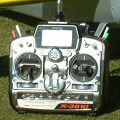|
|||
|
|
|
||
| View Shopping Cart |
| Home |
| Guides Available |
| About the Author |
| FAQs |
| Testimonials |
| Articles |
| Contact Andrew |
| Terms & Conditions |
| Mailing List |
| Links |
 |
 |
Gibbs Guides.com
More high
quality information absolutely
free with every
Gibbs Guides newsletter.
Sign
up now!
Which mode?
By Andrew Gibbs
Which
mode?
The sticks are kept centred
by light springs, except
for the throttle function
which has a ratchet fitted
making it easy to hold the
required throttle position.
An RC model is usually set up to be controlled by the transmitter in one of two modes. These are known as ‘mode 1’ and ‘mode 2’. A 4 channel model will be set up as outlined in the table below:
|
Left stick |
Right stick |
Mode 1 |
Rudder/Elevator |
Aileron/Throttle |
Mode 2 |
Rudder/Throttle |
Aileron/Elevator |
In both modes, forward stick (push away from you) selects more power or down elevator. Left stick will select left rudder or left aileron (left aileron up, right one down) and vice versa.
Mode
1
The primary controls of
a model are the aileron
and elevator. The argument
for Mode 1 is that because
these primary controls are
controlled by separate sticks,
they can be manipulated
independently without any
chance of the other one
being affected. Proponents
of mode 1 argue that this
makes it is easier to control
a model with a high degree
of precision.

In Mode 2, motor power is
controlled by the left stick of the transmitter. Unlike the other
controls, a ratchet allows a selected stick position to be held
easily. |
Mode
2
Mode 2 more closely represents
the controls of a full size
aircraft, and for this reason
it may appeal more strongly
to some modelers. If you
already have full size flying
experience, or are at least
familiar with the controls
of aircraft then mode 2
may well seem the most natural
choice for model flying.
This was certainly the case
for me. Another factor in
its favour is that most
people are right handed
so it may seem easier to
use the right hand for the
primary controls.
The disadvantage of mode 2 is that the primary controls of elevator and aileron are on the same stick, and this can present a little difficulty if for example a change in aileron deflection is required while holding a constant elevator position.
Three
channel models
A 3 channel model (sometimes referred to as a ‘rudder elevator’
model) will of course dispense with the aileron function. In this case,
the rudder controls may be set up like this:
|
Left stick |
Right stick |
Mode 1 |
Elevator |
Rudder/Throttle |
Mode 2 |
Throttle |
Rudder/Elevator |
Which
mode is right for you?
Certainly there are plenty of very skilled pilots of either mode, and
it’s not possible to watch a model being flown and deduce which
mode the pilot is using. Each of the two modes is more popular in certain
geographical areas than others. It’s probably fair to say that mode
2 is the more widely used, at least in the UK. Mode 2 is standard in the
USA.
Ultimately, it’s probably best to go with the mode prevailing at your local club unless you have a particular reason for wanting to be different. In any case, choose your mode carefully because once you've learned one mode, you'll be very reluctant to change. I once was offered a flight with a simple trainer on a mode 1 transmitter while on holiday in Australia. Being a mode 2 pilot, I found flying this simple model very difficult! The experience was quite humbling and served to remind me how much of a challenge learning to fly can be.
Transmitter
tray
Some modelers find a transmitter tray and/or a neck strap
helpful. These relieve you of the job of supporting the
transmitter, perhaps making it easier to concentrate on
manipulating the sticks.